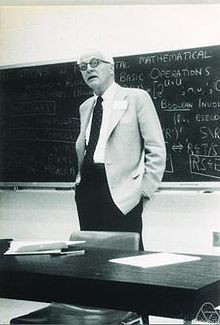Garrett Birkhoff
Garrett Birkhoff (born January 19, 1911 in Princeton , New Jersey , USA ; † November 22, 1996 in Water Mill , NY , USA) was an American mathematician who studied algebra and applied mathematics (hydrodynamics).
Live and act
Birkhoff was the son of the well-known mathematician George David Birkhoff . His father made him home-school until he was eight years old, and while in college he received private tuition in mathematics from his graduate students (Whitney, Morse, Walsh, and Brinkmann). From 1928 Garrett Birkhoff studied at Harvard University with Oliver Kellogg (potential theory), Heinrich Wilhelm Brinkmann (advanced calculus), Joseph L. Walsh (function theory), Marston Morse and Hassler Whitney, among others . Initially he wanted to become a theoretical physicist and studied quantum mechanics at EC Kemble and electrodynamics with George W. Pierce .
After graduating in 1932, he went on a scholarship to Cambridge University in England, where he turned to abstract algebra (group theory) - a lecture by Paul Dirac on quantum mechanics had been rather demotivating - and studied with Philip Hall . A joint work of the two appeared in 1936. In July 1933 he was briefly in Munich with Constantin Carathéodory , who drew his attention to van der Waerden's algebra textbook for his studies and to the descriptive textbook by Andreas Speiser in group theory . From 1933 he was a Fellow at Harvard and from 1936 an instructor; from 1937 he also gave algebra lectures there for beginners, alternating with Saunders MacLane . This resulted in her textbook Survey of Modern Algebra , which appeared in 1941, was intended as an introduction to undergraduate students and was also popular with non-mathematicians. It contributed much to the early interest in abstract algebra in the United States; Usually, beginners' lectures back then tended to focus more on analysis and geometry. At the same time, Birkhoff dealt with association theory , his book Lattice Theory was published as early as 1940. At that time he did not yet know that Richard Dedekind had already anticipated a lot with his dual groups.
During the Second World War, Birkhoff worked in applied mathematics, for example on the Aberdeen Proving Ground , the ballistics research center of the US Army, on grenade explosions, shock waves around projectiles, and distance measurement with radar. This later resulted in two books on hydrodynamics ( Hydrodynamics 1950, Jets, Wakes and Cavities 1957). He has been working with John von Neumann on committees for applied mathematics since the 1940s .
As a consultant for Westinghouse in 1954, he also began working on numerical linear algebra . As a consultant for General Motors from 1959, he advocated the use of cubic spline functions for the modeling of car bodies.
In 1969 he became a George Putnam Professor at Harvard, which he remained until his retirement in 1981. In 1970 he published a more application-oriented algebra textbook with Thomas Bartee ( Modern Applied Algebra ).
In 1978 he received the Birkhoff Prize for Applied Mathematics, named after his father . He was a six-time honorary doctor and a member of the National Academy of Sciences , the American Academy of Arts and Sciences (1945) and the American Philosophical Society (1960). The Birkhoff integral , the Poincaré-Birkhoff-Witt theorem and the Birkhoff representation theorem are associated with his name.
selected Writings
- Garrett Birkhoff: Lattice Theory . AMS, Providence (RI) 1940 (3rd edition. 1973, ISBN 0-8218-1025-1 ).
- Garrett Birkhoff, Gian-Carlo Rota : Ordinary Differential Equations . Ginn-Blaisdell, Boston (MA) 1959 (4th edition. Wiley, Boston 1989, ISBN 0-471-86003-4 ).
- Garrett Birkhoff, Thomas Creson Bartee: Applied Algebra . Oldenbourg, Munich 1973, ISBN 3-486-34231-2 .
- Garrett Birkhoff: Current trends in algebra . In: Amer. Math. Monthly . No. 80 , 1973, pp. 760–782 ( online - for this contribution he received the Lester Randolph Ford Award in 1974).
literature
- Donald J. Albers, GL Alexanderson: Mathematical People - Profiles and Interviews. Birkhäuser, 1985, ISBN 3-7643-3191-7 .
Web links
- Literature by and about Garrett Birkhoff in the catalog of the German National Library
- John J. O'Connor, Edmund F. Robertson : Garrett Birkhoff. In: MacTutor History of Mathematics archive .
Individual evidence
- ^ Birkhoff's interview in Albers, Alexanderson, Mathematical People
| personal data | |
|---|---|
| SURNAME | Birkhoff, Garrett |
| BRIEF DESCRIPTION | American mathematician |
| DATE OF BIRTH | January 19, 1911 |
| PLACE OF BIRTH | Princeton , New Jersey |
| DATE OF DEATH | November 22, 1996 |
| Place of death | Water Mill , NY |
